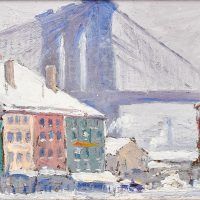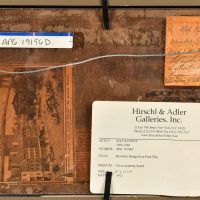



Max Kuehne
German-American, 1880 – 1968
Brooklyn Bridge from Peck Slip, 1912
Oil on academy board
8 H. x 11 ½ W. inches
Max Kuehne was born in Halle, Germany on November 7, 1880. During his adolescence the family immigrated to America and settled in Flushing, New York. As a young man, Max was active in rowing events, bicycle racing, swimming and sailing. After experimenting with various occupations, Kuehne decided to study art, which led him to William Merritt Chase’s famous school in New York; he was trained by Chase himself, then by Kenneth Hayes Miller. Chase was at the peak of his career, and his portraits were especially in demand. Kuehne would have profited from Chase’s invaluable lessons in technique, as well as his inspirational personality. Miller, only four years older than Kuehne, was another of the many artists to benefit from Chase’s teachings. Even though Miller still would have been under the spell of Chase upon Kuehne’s arrival, he was already experimenting with an aestheticism that went beyond Chase’s realism and virtuosity of the brush. Later Miller developed a style dependent upon volumetric figures that recall Italian Renaissance prototypes.
Kuehne moved from Miller to Robert Henri in 1909. Rockwell Kent, who also studied under Chase, Miller, and Henri, expressed what he felt were their respective contributions: “As Chase had taught us to use our eyes, and Henri to enlist our hearts, Miller called on us to use our heads.” (Rockwell Kent, It’s Me O Lord: The Autobiography of Rockwell Kent. New York: Dodd, Mead and Co., 1955, p. 83). Henri prompted Kuehne to search out the unvarnished realities of urban living; a notable portion of Henri’s stylistic formula was incorporated into his work.
Having received such a thorough foundation in art, Kuehne spent a year in Europe’s major art museums to study techniques of the old masters. His son Richard named Ernest Lawson as one of Max Kuehne’s European traveling companions. In 1911 Kuehne moved to New York where he maintained a studio and painted everyday scenes around him, using the rather Manet-like, dark palette of Henri.